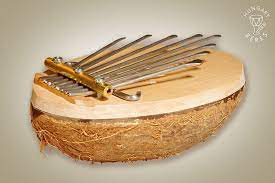Jungle Instruments – Music made from natural materials
Hardly any tree is as useful and versatile as the coconut palm, which is native to the tropical regions of this earth. From shelter to skin care to food and music instruments – this palm can do simply everything.
The core of the trunk is soft and moist because this is where the water is transported up from the root. The outer layer of the trunk is rock hard: when the wood reaches a certain age, you can no longer hammer a nail into it. Despite its high stability, the trunk is very flexible and can survive hurricanes of the highest category, also thanks to its massive root system. Due to their strength, the logs are often used in the construction of houses in tropical regions.
Coconut – Jungle Instruments
The leaves, or rather the palm fronds, can be woven into a rainproof shelter and roof. But they also serve as excellent raw material for baskets, mats for sitting, sleeping and eating. The fruit of the palm, the coconut, is so versatile that you can process all of its components – even the soft fibers, thanks to which the coconut lands gently, are useful. They are used to make ropes, doormats, hats, baskets, carpets, thermal insulation and filling material for mattresses and upholstery.
The hard shell is also still very valuable after the coconut water and copra are extracted from it and the outer fibers are utilized. Drinking vessels, bowls, spoons, vases and jewelry can be made from a coconut shell cut in half. It is also possible to make musical instruments, in which the shell then serves as a resonating body.
Jungle Instruments – Calimba
The kalimba, an extraordinary instrument with African origins. The way of playing is comparable with a thumb piano. The kalimba belongs to the so-called lamellophones. Consisting of a board with a hollow body and with the approximate size of a book, the instrument has the advantage of being easily played in the hand.

The slats, which are attached to the piece of wood, are usually made of metal. In the first versions these were also made of wood, coconut, sugar cane or bamboo. As a rule, the instrument is held with both hands and played with the thumbs by plucking the metal lamellae and thus setting them in vibration. The sounding body of the Jungle Kalimba consists of half a coconut. The instruments are lovingly handmade and painted. Each calimba is unique.
Coconut rattles
Another common coconut instrument is the rattle. The rattle heads are made from a beveled and polished coconut. There are mostly filled with maracas, fine volcanic riddle, and sand, it creates a fine but fiery rattle sound. These rattles are often used in shamanic journeys.
Bamboo Jungle Instruments
Bamboo is one of the fastest growing raw materials in the world. It absorbs large amounts of CO2 during its growth. With equivalent or even better properties than hardwood, Moso Bamboo is the ideal alternative to the increasingly scarce tropical hardwood.
Bamboo is also a very popular material for musical instruments, of course. Especially for wind instruments, such as didgeridoos or flutes, but also for percussion instruments, the inexpensive and sustainable raw material is often used.
Individual Jungle Instruments
The instruments made out of natural materials like coconut and bamboo are all handmade and individual. This means every instrument has a unique sound and is a single piece. In Costa Rica you can find lots of handcrafted instruments perfect for musicians and music lovers.
jungle music example – why is jungle music called jungle – jungle band – jungle genre – jungle electronic music – Jungle Instruments


